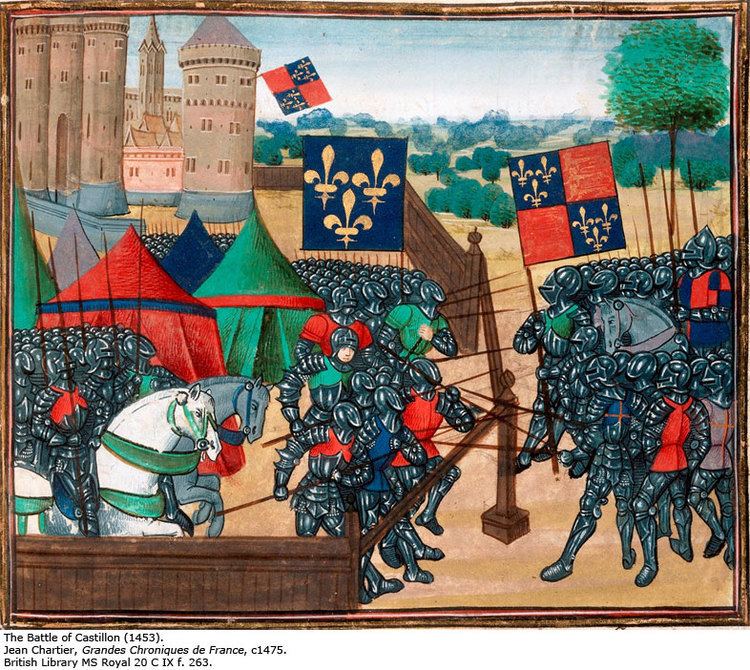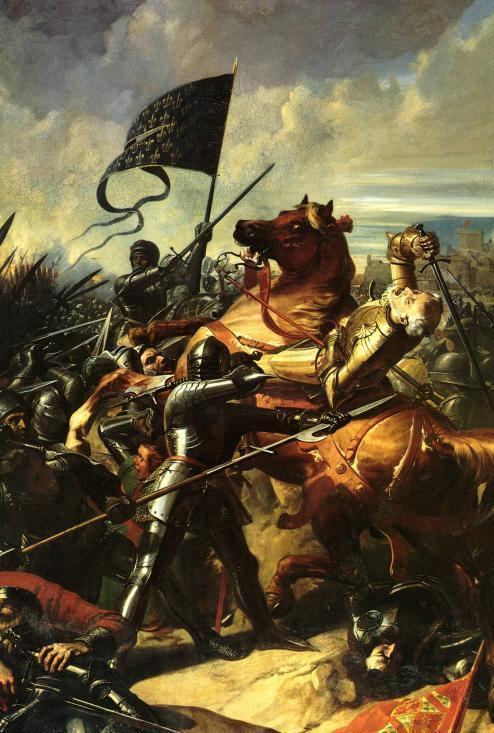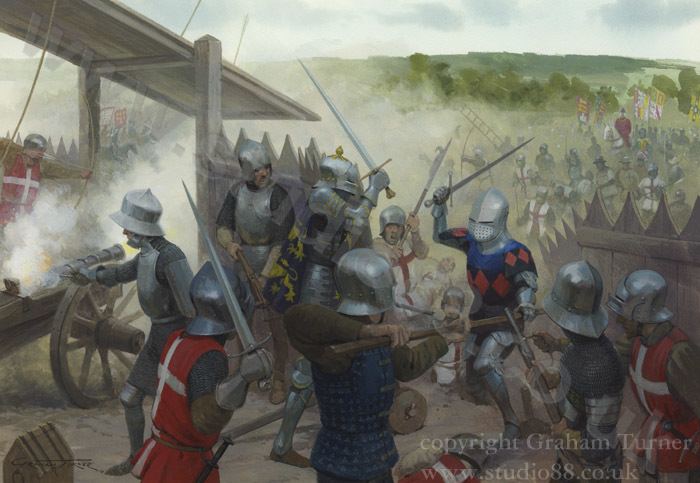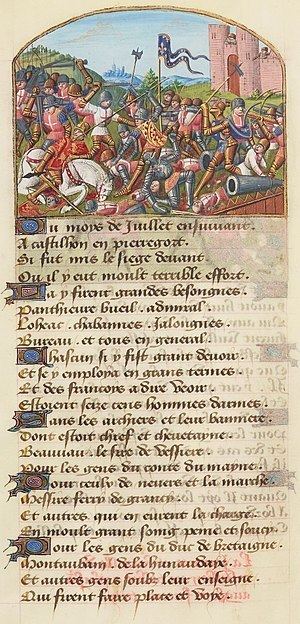c. est. 6,000-10,000 c. est. 7,000-10,000 Date 17 July 1453 | 4,000 dead, wounded, or captured 100 dead or wounded | |
 | ||
Similar Hundred Years' War, Battle of Formigny, Battle of Patay, Battle of Verneuil, Battle of Poitiers | ||
Battle of castillon 1453 medieval ii total war machinima
The Battle of Castillon was a battle fought on 17 July 1453 in Gascony near the town of Castillon-sur-Dordogne (later Castillon-la-Bataille). A decisive French victory, it is considered to mark the end of the Hundred Years' War. As a result of the battle, the English lost all landholdings in France, except Calais.
Contents
- Battle of castillon 1453 medieval ii total war machinima
- The battle of castillon 3d battle map version the last battle of the 100 years war
- Background
- Preparation
- Main battle
- Aftermath
- References
The battle of castillon 3d battle map version the last battle of the 100 years war
Background

The term "Hundred Years' War" is misleading, as the fighting between the English and the French during the period of 1337 to 1453 was more a series of conflicts than a single prolonged war. Thus, the conflict(s) can be examined from the vantage point of various stages. The breakdown of the 1420 Treaty of Troyes began the final stage of the Hundred Years' War. This period from 1420 to 1453 is characterized by Anne Curry as the “wars of the Treaty of Troyes” for control of the crown of France.

After the 1451 French capture of Bordeaux by the armies of Charles VII, the Hundred Years' War appeared to be at an end. The English primarily focused on reinforcing their only remaining possession, Calais, and watching over the seas. However, after three hundred years of Plantagenet rule, the citizens of Bordeaux considered themselves subjects of the English monarch and sent messengers to Henry VI of England demanding that he recapture the province.

On 17 October 1452, John Talbot, Earl of Shrewsbury landed near Bordeaux with a force of 3,000 men. A feared and famous military leader, Talbot was rumored to be seventy-five or eighty years old, but it is more likely that he was around sixty-six at the time. With the cooperation of the townspeople, Talbot easily took the city on October 23. The English subsequently took control over most of Western Gascony by the end of the year. The French knew an expedition was coming, but had expected it to come through Normandy. After this surprise, Charles VII prepared his forces over the winter, and by the spring of 1453 he was ready to counter-attack.
Preparation

Charles invaded Guyenne with three separate armies, all headed for Bordeaux. Talbot received 3,000 additional reinforcements from his fourth and favorite son, Viscount Lisle. The French laid siege to Castillon on July 8. Talbot acceded to the pleas of the town commanders, abandoning his original plan to wait for reinforcements at Bordeaux, and set out to relieve the garrison.

The French army was commanded by committee; however, it was Charles VII's ordnance officer, Jean Bureau who laid out the camp to maximize French artillery strength. In a defensive setup, Bureau's forces built an artillery park out of range from Castillon's guns. According to Desmond Seward, the park "consisted of a deep trench with a wall of earth behind it which was strengthened by tree-trunks; its most remarkable feature was the irregular, wavy line of the ditch and earthwork, which enable the guns to enfilade any attackers". The park included up to 300 guns of various sizes, and was protected by a ditch and palisade on three sides and a steep bank of the River Lidoire on the fourth.
Talbot left Bordeaux on July 16. He outdistanced a majority of his forces, arriving at Libourne by sunset with only 500 men-at-arms and 800 mounted archers. The following day, this force defeated a small French detachment of archers stationed at a priory near Castillon. Despite earlier plans to wait for reinforcements, Talbot pressed his men onward to the French camp, believing his reinforcements would arrive soon.
Main battle
Along with the morale boost of victory at the priory, Talbot also pushed forward because of reports that the French were retreating. However, the cloud of dust leaving the camp which the townsmen indicated as a retreat was created by camp followers leaving before the upcoming battle.
The English advanced, but they ran into the full force of the French army. Despite being outnumbered and in a vulnerable position, Talbot ordered them to continue the fighting. Historian A.J. Pollard suggests this seemingly reckless behavior from Talbot may be due to the fact that his "pride and honour were at stake for he had already ordered his men to battle when he discovered the strength of the French position". The only Englishman who remained mounted in the battle, he also did not wear armor due to previous agreements with the French when he was released from captivity in Normandy.
According to David Nicolle, the battle itself was "highly characteristic of the period" with the strong field fortification of the French and the small-arms fighting of the battle. In many ways, this battle played out like the Battle of Crécy in "reverse". The French guns decimated the advancing soldiers. It is reported each shot killed six men at a time. Talbot's reinforcements continued to arrive at the battle, only to suffer the same fate. Despite the odds against the English, the battle lasted over an hour until a thousand-strong Breton cavalry led by Peter II, the Duke of Brittany crashed into their right flank, sending them into retreat.
In the end, the French routed the English. Both Talbot and his son died in the battle. There is some debate over the exact circumstances of Talbot's death, but it appears as though his horse was killed by a projectile, its mass pinned him down, and then a French archer killed him with an axe. His death, and the subsequent recapture of Bordeaux three months later, effectively ended the Hundred Years' War.
Aftermath
With Talbot's death, English authority in Gascony eroded and the French retook Bordeaux on 19 October 1453. It was not apparent to either side, however, that the period of conflict was over. In hindsight, the battle clearly marks a decisive turning point in history, and is cited as the endpoint of the period known as the Hundred Years' War.
Henry VI of England lost his mental capacity in late 1453, which led to the outbreak of the Wars of the Roses in England. Some have speculated that learning of the defeat at Castillon led to Henry's mental collapse. The English Crown lost all its continental possessions except for the Pale of Calais, which was the last English possession in mainland France, and the Channel Islands, historically part of the Duchy of Normandy and thus of the Kingdom of France. Calais was finally lost in 1558. The Channel Islands have remained British Crown Dependencies to this date. After the effective end of the Hundred Years' War, weakened and traumatised by the defeat, the English never attacked France without the support of a strong coalition.
A casualty after the battle of Castillon was Pierre II de Montferrand, husband of Mary Plantagenet, illegitimate daughter of the Duke of Bedford and a granddaughter of Henry IV of England. On returning to France, after being exiled in England, Montferrand was arrested and taken to Poitiers where he was tried by a commission. Having been found guilty he was beheaded and quartered, possibly on the orders of Charles VII, at Poitiers, in July 1454. Montferrand was one of only a small number of nobles known to have been executed for treason during the reign of Charles VII.
